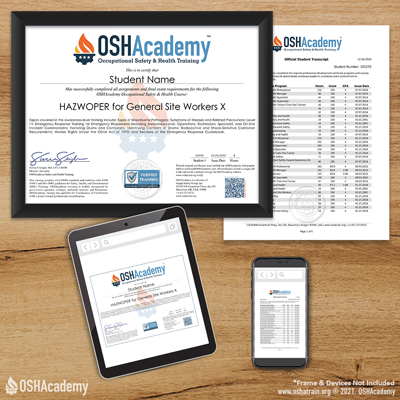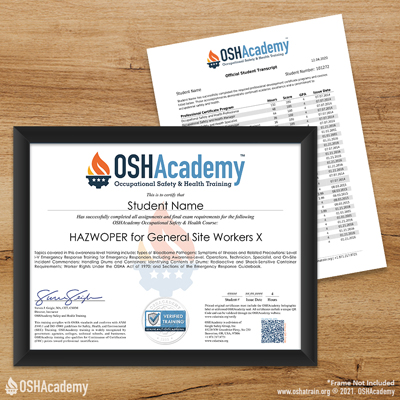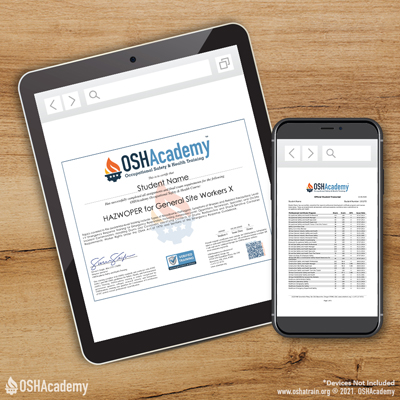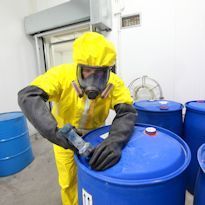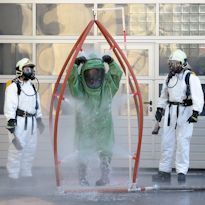669 HAZWOPER for General Site Workers X
This is the tenth in a ten-course series comprising the 40-hour HAZWOPER for General Site Workers certificate program per OSHA Standard 29 CFR 1910.120.
This course covers training requirements related to common hazards in the construction industry. Topics will include scaffold safety; slips, trips, and falls; ladders and stairways; working with electricity; excavation and trenching; cranes and rigging; powered industrial trucks and heavy equipment.
OSHA Requirements
It is important to understand the 40-hour HAZWOPER is a two-phase process:
- 40 hours of off-site instruction
- 3 days of worksite-specific practice in the field
OSHAcademy online training fulfills the first phase of this process. An employer must provide the 3 days of worksite-specific, hands-on practice in the field.
Time Requirement
OSHA Standard 1910.120 requires students to complete 40-hours of off-site training as part of this program. OSHAcademy has divided the 40-hour HAZWOPER program into ten courses. Each course has a minimum time requirement, which must be met before a student is granted access to the course exam.
This course has a minimum time requirement of 5 hours. You can monitor your time on this course using the timer located in the top-left corner of each page.
IACET Accreditation
OSHAcademy is accredited by the International Accreditors for Continuing Education and Training (IACET) and offers IACET CEUs for courses that meet ANSI/IACET standards. IACET is globally recognized for promoting the quality of continuing education and training.

Free Access
As an OSHAcademy student, you have free access to all our training materials, including knowledge checks and course activities. Documentation of your training–such as exam scores, certificates, and transcripts–can be accessed by purchasing a certificate package.
Important Information
HAZWOPER course certificates are not available for purchase individually. To receive certificates for the HAZWOPER courses, you must purchase a 40-hour HAZWOPER program package.
| Modules: | 5 |
| Hours: | 4 |
| Sectors: | General Industry |
| IACET: | 0.4 CEUs |
Fee
HAZWOPER course certificates are included when you purchase a 40-hour HAZWOPER program package.
Individual HAZWOPER course certificates cannot be purchased separately.
-
Key Topics
-
Target Audience
Frequently Asked Questions (FAQs)
The Hazardous Waste Operations and Emergency Response Standard (HAZWOPER) applies to five (5) distinct groups of employers and their employees. This includes any employees who are exposed or potentially exposed to hazardous substances, including hazardous waste, and who are engaged in one of the following operations as specified by 1910.120(a)(1)(i-v) and 1926.65(a)(1)(i-v):
- Clean-up operations, required by a governmental body, whether federal, state, local, or others involving hazardous substances, that are conducted at uncontrolled hazardous waste sites
- Corrective actions involving clean-up operations at sites covered by the Resource Conservation and Recovery Act of 1976 (RCRA) as amended (42 U.S.C. 6901 et seq.)
- Voluntary clean-up operations at sites recognized by federal, state, local, or other governmental body as uncontrolled hazardous waste sites
- Operations involving hazardous wastes that are conducted at treatment, storage, and disposal facilities regulated by Title 40 Code of Federal Regulations Parts 264 and 265 pursuant to RCRA, or by agencies under agreement with U.S. Environmental Protection Agency to implement RCRA regulations
- Emergency response operations for releases of, or substantial threats of releases of, hazardous substances regardless of the location of the hazard
Yes, the exemptions are:
- Any treatment, storage, or disposal (TSD) operation regulated by 40 CFR parts 264 and 265 or by state law authorized under Resource Conservation and Recovery Act (RCRA), and required to have a permit or interim status from EPA pursuant to 40 CFR 270.1 or from a state agency pursuant to RCRA
- Any area of a treatment, storage, or disposal (TSD) facility not used primarily for treatment, storage, or disposal, or any emergency response operations
- Employers who are not required to have a permit or interim status because they are generators who qualify under 40 CFR 262.34 for exemptions from regulation under 40 CFR parts 264 and 265
- Employers who are not required to have a permit or interim status because they are a conditionally exempt small quantity generator under 40 CFR 261.5
- Emergency response operations for releases of, or substantial threats of releases of, hazardous substances which are not covered by the first four qualifying examples above must only comply with the requirements of an Emergency Response Plan
OSHA provides a page that you may find helpful that discusses the application of HAZWOPER to worksite response and cleanup activities.
To answer the question, let's begin with the HAZWOPER regulation, including Appendix E, and OSHA 2254 - Training Requirements in OSHA Standards and Training Guidelines.
Hazardous Waste Operations and Emergency Response Training - General
All employees working on site (such as but not limited to equipment operators, general laborers and others exposed to hazardous substances, health hazards, or safety hazards and their supervisors and management responsible for the site shall receive training before they are permitted to engage in hazardous waste operations that could expose them to hazardous substances, safety or health hazards, as well as receive review training.
Employees shall not be permitted to participate in or supervise field activities until they have been trained to a level required by their job function and responsibility in the following areas:
- Names of personnel and alternates responsible for site safety and health
- Safety, health and other hazards present on the site
- Use of personal protective equipment
- Work practices by which the employee can minimize risks from hazards
- Safe use of engineering controls and equipment on the site
- Medical surveillance requirements, including recognition of symptoms and signs which might indicate overexposure to hazards
Initial Training
- General site workers (such as equipment operators, general laborers and supervisory personnel) engaged in hazardous substance removal or other activities which expose or potentially expose workers to hazardous substances and health hazards shall receive a minimum of 40 hours of instruction off the site, and a minimum of three (3) days actual field experience under the direct supervision of a trained, experienced supervisor.
- Workers on site only occasionally for a specific limited task (such as, but not limited to, ground water monitoring, land surveying, or geophysical surveying) and who are unlikely to be exposed over permissible exposure limits (PELs) and published exposure limits shall receive a minimum of 24 hours of instruction off the site, and the minimum of one (1) day actual field experience under the direct supervision of a trained, experienced supervisor.
- Onsite management and supervisors directly responsible for, or who supervise employees engaged in, hazardous waste operations shall receive 40 hours initial training, three (3) days of supervised field experience, and at least eight (8) additional hours of specialized training at the time of job assignment. Please note: In some specific low hazard cases, Managers and Supervisors may be able to take 24 hours of initial training instead of 40 hours, but still need to take the three (3) days on site and the additional eight (8) hours of specialized training.
Other specific training requirements are:
- Employees, managers and supervisors shall receive eight (8) hours of refresher training annually.
- There are many additional requirements for clean up and emergency responders. You should review HAZWOPER regulations including Appendix E. Employees who are engaged in responding to hazardous emergency situations at hazardous waste cleanup sites that may expose them to hazardous substances shall be trained in how to respond to such expected emergencies.
- Workers regularly on site who work in areas which have been monitored and fully characterized indicating that exposures are under permissible exposure limits and published exposure limits where respirators are not necessary, and the characterization indicates that there are no health hazards or the possibility of an emergency developing, shall receive a minimum of 24 hours of instruction off the site and a minimum of one day actual field experience under the direct supervision of a trained, experienced supervisor.
- In general, workers that have received 24 hours of training who become general site workers or who are required to wear respirators, shall have the additional 16 hours and two days of training.
Yes. There are two primary phases in OSHA's 40-hour HAZWOPER training requirement:
- Off-site classroom or online instruction (40 hours) - In an effective training program, it is critical trainees have the opportunity to ask questions where material is unfamiliar to them. In an online computer-based training program, this requirement may be accomplished through the use of a phone or an e-mail contact at the time the training is being conducted so trainees have direct access to a qualified trainer at the time their questions are raised. OSHAcademy has trained instructors who can answer your questions over the phone or via email, usually the same day.
- Worksite-specific hands-on training (3 days) - This phase of the training cannot be completed in the classrom or online. Trainees must have hands-on experience and exercises in the field to provide an opportunity to become familiar with equipment and safe practices in a non-hazardous setting. The purpose of hands-on training is two-fold: (1) to ensure workers can learn by practical experience and, (2) to assess whether workers have adequate skills. The employer is responsible for ensuring employees complete this phase of the HAZWOPER training requirement.

